Experimental Study on Water-in-Heavy-Oil Droplets Stability and Viscosity Variations in the Dilution Process of Water-in-Heavy-Oil Emulsions by Light Crude Oil
Abstract
1. Introduction
2. Materials and Methods
2.1. Materials
2.2. Experimental Apparatus
2.3. Experimental Procedures
- (1)
- Dehydration. Crude oil was dehydrated and degassed using the electric dehydrator under the temperature of 120 °C for about 12 h firstly, and microscopic analysis was employed to ensure that water is removed thoroughly during the dehydration.
- (2)
- Heavy oil emulsion preparation. Heavy oil emulsions with varied water contents of 30%, 40%, 50% and 60% (named A30, A40, A50 and A60, respectively) were obtained by mixing crude oil and water by stirring.
- (3)
- Diluted heavy oil emulsion samples preparations. Heavy oil emulsions were mixed with varied ratio of light crude oil to obtain diluted heavy oil emulsions, and the dilution ratio were 1:7, 2:8, 3:7. Heavy oil emulsions and diluted heavy oil emulsions preparation process is shown in Figure 2.
- (4)
- Tests. Microscopic observation of diluted heavy oil emulsions performed by Olympus BX53 Microscope. and the rheological tests by Haake MARS III rotational rheometer were performed on heavy oil emulsions and diluted heavy oil emulsion samples.
3. Results and Discussion
3.1. Water Fraction’s Effect on W/O Emulsion Viscosity
3.2. The Dilution Ratio’s Effect on W/O Emulsion Viscosity
3.3. W/O Droplets Stability in the Dilution Process
3.4. Viscosity Prediction of Diluted Water-in-Heavy-Oil Emulsions
4. Conclusions
- (1)
- The heavy oil emulsions viscosity increased from 1453 mPa·s to 9854 mPa·s as the water fractions range from 0% to 60%. Furthermore, the W/O droplets size distribution range increased with the water content increasing, reflecting the W/O droplets stability.
- (2)
- Mixing with light crude oil could reduce the viscosity of heavy oil emulsions and improve the flowability effectively. The viscosity reduction rate by dilution increased as the water content increased when the water fraction was less than 60%.
- (3)
- The microscopic analysis about W/O droplets distribution and their size could reveal that the dilution process probably affects the oil–water film stability by adjusting interfacial electrostatic properties, as well as the repulsion between W/O droplets. The demulsification would assist the viscosity reduction effect by dilution. In conclusion, the synergistic effects of the dilution effects of dissolving heavy components and the weakened oil–water film stability in the dilution process would reduce the viscosity of W/O emulsions.
- (4)
- The poor performance of the Richardson model for predicting viscosities of diluted water in heavy oil emulsions may be related to the emulsification between free water and crude oil and demulsification. The modified Richardson model which introduced coefficients of variable constants showed a significant improvement of prediction accuracy, especially for diluted water in heavy oil emulsions with large water fractions.
Author Contributions
Funding
Data Availability Statement
Acknowledgments
Conflicts of Interest
Nomenclature
| The viscosity of the diluted heavy oil, mPa·s | |
| The viscosity of heavy oil, the viscosity of diluent oil, mPa·s | |
| The mass fraction of heavy oil, the mass fraction of diluent oil | |
| The viscosity of the mixture of heavy oil and diluent oil, mPa·s | |
| The viscosity of crude oil, mPa·s | |
| The water content ratio | |
| Variable constants | |
| the volume fraction of heavy oil, the volume fraction of diluent oil |
References
- Wang, Z.Q.; Fan, Z.; Chen, X.; Fan, Z.; Wei, Q.; Wang, X.; Yue, W.; Liu, B.; Wu, Y. Global oil and gas development in 2022: Situation, trends and enlightenment. Pet. Explor. Dev. 2023, 50, 1167–1186. [Google Scholar] [CrossRef]
- Bosikov, I.I.; Klyuev, R.V.; Gavrina, O.A. Analysis of geological-geophysical materialsand qualitative assessment of the oil and gas perspectives of the Yuzhno-Kharbizhinsky area (Northern Caucasus). Geol. I Geofiz. Yuga Ross. = Geol. Geophys. Russ. South 2021, 11, 6–21. (In Russian) [Google Scholar]
- Meng, M.; Peng, J.; Ge, H.; Ji, W.; Li, X.; Wang, Q. Rock fabric of lacustrine shale and its influence on residual oil distribution in the Upper Cretaceous Qingshankou Formation, Songliao Basin. Energy Fuels 2023, 37, 7151–7160. [Google Scholar] [CrossRef]
- Gomaa, K.G.; Salem, A.N. El-hoshoudy. Recovery of Heavy Oil and Extra Heavy Oil; Current Status, New Trends, and Enhancement Techniques. Petroleum, 2023; in press. [Google Scholar] [CrossRef]
- Temizel, C.; Kirmaci, H.; Inceisci, T. Production Optimization in Heavy Oil Recovery Processes. In Proceedings of the SPE Heavy Oil Conference and Exhibition, Kuwait City, Kuwait, 6–8 December 2016; OnePetro: Richardson, TX, USA, 2016. [Google Scholar]
- Ilyin, S.; Arinina, M.; Polyakova, M.; Bondarenko, G.; Konstantinov, I.; Kulichikhin, V. Asphaltenes in heavy crude oil: Designation, precipitation, solutions, and effects on viscosity. J. Petrol. Sci. Eng. 2016, 147, 211–217. [Google Scholar] [CrossRef]
- Mikula, R.J.; Kasperski, K.L.; Burns, R.D.; MacKinnon, M.D. Nature and fate of oil sands fine tailings. In Suspensions: Fundamentals and Applications in the Petroleum Industry; Schramm, L.L., Ed.; Advances in Chemistry; American Chemical Society (ACS): Washington, DC, USA, 1996; Volume 251, Chapter 14; pp. 677–726. [Google Scholar]
- Liu, J.B.; Liu, S.; Zhang, W.; Zhong, L.G. Influence of Emulsification Characteristics on the Pressure Dynamics during Chemical Flooding for Oil Recovery. Energy Fuels 2023, 37, 4308–4319. [Google Scholar] [CrossRef]
- Xu, K.; Liang, T.; Zhu, P.; Qi, P.; Lu, J.; Huh, C.; Balhoff, M. A 2.5-D glass micromodel for investigation of multi-phase flow in porous media. Lab Chip 2017, 17, 640–646. [Google Scholar] [CrossRef] [PubMed]
- Zhou, X.; Dong, M.; Maini, B. The dominant mechanism of enhanced heavy oil recovery by chemical flooding in a two dimensional physical model. Fuel 2013, 108, 261–268. [Google Scholar] [CrossRef]
- Soo, H.; Radke, C.J. Flow mechanism of dilute, stable emulsions in porous media. Ind. Eng. Chem. Res. 1984, 23, 342–347. [Google Scholar] [CrossRef]
- Zhao, H.W. Experimental Research on Formation and Demulsification of Heavy Oil Emulsion in Bohai Sea. Master’s Thesis, Northeast Petroleum University, Daqing, China, 2017. [Google Scholar]
- Sun, H.Q.; Liu, H.Q.; Wang, H.T. Development technology and direction of thermal recovery of heavy oil in China. Acta. Petrol. Sin. 2022, 43, 1664–1674. [Google Scholar]
- Mohammadian, E.; Taju Ariffin, T.S.; Azdarpour, A.; Hamidi, H.; Yusof, S.; Sabet, M.; Yahya, E. Demulsification of Light Malaysian Crude Oil Emulsions Using an Electric Field Method. Ind. Eng. Chem. Res. 2018, 57, 13247–13256. [Google Scholar] [CrossRef]
- Lee, T.; Cho, J.; Lee, J. Mixing Properties of Emulsified Fuel Oil from Mixing Marine Bunker-C Fuel Oil and Water. J. Mar. Sci. Eng. 2022, 10, 1610. [Google Scholar] [CrossRef]
- Saad, M.A.; Kamil, M.; Abdurahman, N.H.; Yunus, R.M.; Awad, O.I. An Overview of Recent Advances in State-of-the-Art Techniques in the Demulsification of Crude Oil Emulsions. Processes 2019, 7, 470. [Google Scholar] [CrossRef]
- Salam, K.; Alade, A.O.; Arinkoola, A.O. Improving the Demulsification Process of Heavy Crude Oil Emulsion through Blending with Diluent. J. Petrol. Eng. 2013, 2013, 793101. [Google Scholar] [CrossRef]
- Christophe, D.; David, A.; Anne, S.; Alain, G.; Patrick, B. Stability of water/crude oil emulsions based on interfacial dilatational rheology. J. Colloid. Interf. Sci. 2006, 297, 785–791. [Google Scholar]
- Rondon, M.; Pereira, J.C.; Bouriat, P.; Graciaa, A.; Lachaise, J.; Salager, J.L. Breaking of water-in-crude-oil emulsions. 2.Influence of asphaltene concentration and diluent nature on demulsifier action. Energy Fuels 2008, 22, 702–707. [Google Scholar] [CrossRef]
- Ekott, E.J.; Akpabio, E.J. Influence of asphaltene content on demulsifiers performance in crude oil emulsions. J. Eng. Appl. Sci. 2011, 6, 200–204. [Google Scholar] [CrossRef][Green Version]
- Khvostichenko, D.S.; Andersen, S.I. Interactions between Asphaltenes and Water in Solutions in Toluene. Energy Fuels 2008, 22, 3096–3103. [Google Scholar] [CrossRef]
- Kilpatrick, P.K. Water-in-Crude Oil Emulsion Stabilization: Review and Unanswered Questions. Energy Fuels 2012, 26, 4017–4026. [Google Scholar] [CrossRef]
- Buckley, J.S.; Liu, Y.; Xie, X.; Morrow, N.R. Asphaltenes and crude oil wetting-the effect of oil composition. SPE J. 1997, 2, 107–119. [Google Scholar] [CrossRef]
- Goual, L.; Horváth-Szabó, G.; Masliyah, J.H.; Xu, Z. Adsorption of Bituminous Components at oil-water Interfaces Investigated by Quartz Crystal Microbalance: Implications to the Stability of Waterin-Oil Emulsions. Langmuir 2005, 21, 8278–8289. [Google Scholar] [CrossRef] [PubMed]
- Paso, K.; Silset, A.; Sorland, G. Characterization of the Formation, Flowability, and Resolution of Brazilian Crude Oil Emulsions. Energy Fuels 2009, 23, 471–480. [Google Scholar] [CrossRef]
- Gao, F.; Xu, Z.; Liu, G.; Yuan, S. Molecular dynamics simulation: The behavior of asphaltene in crude oil and at the oil-water interface. Energy Fuels 2014, 28, 7368–7376. [Google Scholar] [CrossRef]
- Liu, J.; Zhao, P.Y.; Ren, S.L. Molecular Dynamics Simulation of Self-Aggregation of Asphaltenes at an oil-water Interface: Formation and Destruction of the Asphaltene Protective Film. Energy Fuels 2017, 29, 150203133004006. [Google Scholar] [CrossRef]
- Kuznicki, T.; Masliyah, J.H.; Bhattacharjee, S. Molecular Dynamics Study of Model Molecules Resembling Asphaltene-Like Structures in Aqueous Organic Solvent Systems. Energy Fuels 2008, 22, 2379–2389. [Google Scholar] [CrossRef]
- Silva, E.B.; Santos, D.; Alves, D.R.M.; Barbosa, M.S.; Guimaraes, R.C.L.; Ferreira, B.M.S.; Guarnieri, R.A.; Franceschi, E.; Dariva, C.; Santos, A.F.; et al. Demulsification of Heavy Crude Oil Emulsions Using Ionic Liquids. Energy Fuels 2013, 27, 6311–6315. [Google Scholar] [CrossRef]
- Kruyt, H.R. Colloid Science; Elsevier: New York, NY, USA, 1952. [Google Scholar]
- Zapryanov, Z.; Malhotra, A.K.; Aderangi, N.; Wasan, D.T. Emulsion stability: An analysis of the effects of bulk and interfacial properties on film mobility and drainage rate. Int. J. Multiphas. Flow 1983, 9, 105. [Google Scholar] [CrossRef]
- Sarkar, J.; Sharma, A. A Unified Theory of Instabilities in Viscoelastic Thin Films: From Wetting to Confined Films, From Viscous to Elastic Films, and From Short to Long Waves. Langmuir 2010, 26, 8464–8473. [Google Scholar] [CrossRef]
- McLean, J.D.; Spiecker, P.M.; Sullivan, A.P.; Kilpatrick, P.K. The Role of petroleum asphaltenes in the stabilization of water-in-oil- emulsions. In Structures and Dynamics of Asphaltenes; Mullins, O.C., Sheu, E.Y., Eds.; Plenum Press: New York, NY, USA, 1998; Chapter XII; p. 377. [Google Scholar]
- Verruto, V.J.; Le, R.K.; Kilpatrick, P.K. Adsorption and Molecular Rearrangement of Amphoteric Species at Oil–Water Interfaces. J. Phys. Chem. B 2009, 113, 13788–13799. [Google Scholar] [CrossRef]
- Ese, M.H.; Sjöblom, J.; Djuve, J.; Pugh, R. An atomic force microscopy study of asphaltenes on mica surfaces. Influence of added resins and demulsifiers. Colloid. Polym. Sci. 2000, 278, 532–538. [Google Scholar] [CrossRef]
- Nguyen, D.T.; Sadeghi, N.; Houston, C. Emulsion Characteristics and Novel Demulsifiers for Treating Chemical Induced Emulsions. In Proceedings of the Enhanced Oil Recovery Conference of the Society of Petroleum Engineers (SPE), Kuala Lumpur, Malaysia, 19–21 July 2011. SPE Paper 143987. [Google Scholar]
- Nguyen, D.T.; Sadeghi, N. Selection of the Right Demulsifier for Chemical Enhanced Recovery. In Proceedings of the International Symposium on Oilfield Chemistry of the Society of Petroleum Engineers (SPE), The Woodlands, TX, USA, 11–13 April 2011. SPE Paper 140860. [Google Scholar]
- Deng, S.; Bai, R.; Chen, J.P.; Yu, G.; Jiang, Z.; Zhou, F. Effects of alkaline/surfactant/polymer on stability of oil droplets in produced water from ASP flooding. Colloids. Surf. A 2002, 211, 275–284. [Google Scholar] [CrossRef]
- Schramm, L.L.; Stasiuk, E.N.; Turner, D. The influence of interfacial tension in the recovery of bitumen by water-based conditioning and flotation of Athabasca oil sands. Fuel. Process. Technol. 2003, 80, 101–118. [Google Scholar] [CrossRef]
- Li, S.; Li, Z.; Xu, Z.; Ban, X.; Lu, T. Study of rheological properties and micro-mechanism of heavy oil emulsion prepared via ultrasonic dispersion. Energy Fuels 2020, 34, 15843–15854. [Google Scholar] [CrossRef]
- Jiang, Y. Application of blending light droping viscosity testing technology for heavy oil well in Tahe Oilfield. Well. Test. 2004, 13, 2. [Google Scholar]
- Lin, L.X.; Ma, H.Z.; Zeng, F.H. A Critical Review of the Solvent-Based Heavy Oil Recovery Methods. In Proceedings of the SPE Heavy Oil Conference, Calgary, AB, Canada, 10–12 June 2014. [Google Scholar]
- Wu, Y.B.; Liu, X.Q.; Du, X. Scaled physical experiments on drainage mechanisms of solvent-expanded SAGD in super-heavy oil reservoirs. Petrol. Explor. Develop. 2020, 47, 139–145. [Google Scholar] [CrossRef]
- Lyu, C.H.; Zhong, L.G.; Wang, Q.; Zhang, W.; Han, X.D.; Chen, M.Q.; Zhu, Y.; Yang, J.W. Core scale analysis of low viscosity oil injection in enhancing oil recovery of heavy oil reservoirs. Energy 2023, 275, 127432. [Google Scholar] [CrossRef]
- Yang, Z.; Wu, X.; Guo, J.; Zhang, J.; Xiong, R.; Liu, L.; Kiyingi, W. Characterization of Asphaltene Deposition Behavior in Diluted Heavy Oil under High-Pressure Conditions. Energies 2023, 16, 6780. [Google Scholar] [CrossRef]
- Stanford, L.A.; Rodgers, R.P.; Marshall, A.G. Compositional Characterization of Bitumen/Water Emulsion Films by Negative- and Positive-Ion Electrospray Ionization and Field Desorption/Ionization Fourier Transform Ion Cyclotron Resonance Mass Spectrometry. Energy Fuels 2007, 21, 963–972. [Google Scholar] [CrossRef]
- Drelich, J.; Miller, J.D. Surface and interfacial tension of the Whiterocks bitumen and its relationship to bitumen release from tar sands during hot water processing. Fuel 1994, 73, 1504–1510. [Google Scholar] [CrossRef]
- Zhang, H.Y.; Dong, M.Z.; Zhao, S.Q. Experimental Study of the Interaction between NaOH, Surfactant, and Polymer in Reducing Court Heavy Oil/Brine Interfacial Tension. Energy Fuels 2012, 26, 3644–3650. [Google Scholar] [CrossRef]
- Wu, X. Investigating the stability mechanism of water-in diluted bitumen emulsions through isolation and characterization of the stabilizing materials at the interface. Energy Fuels 2003, 17, 179–190. [Google Scholar] [CrossRef]
- Alomair, O.A.; Almusallanv, A.S. Heavy Crude Oil Viscosity Reduction and the Impact of Asphaltene Precipitation. Energy Fuels 2013, 27, 7267–7276. [Google Scholar] [CrossRef]
- Czarnecki, J.; Moran, K. On the stabilization mechanism of water-in-oil emulsions in petroleum systems. Energy Fuels 2005, 19, 2074–2079. [Google Scholar] [CrossRef]
- Yang, X.; Czarnecki, J. The effect of naphtha to bitumen ratio on properties of water in diluted bitumen emulsions. Colloid. Surface A 2002, 211, 213–222. [Google Scholar] [CrossRef]
- He, L.; Lin, F.; Li, X.G.; Sui, H. Enhancing Bitumen Liberation by Controlling the Interfacial Tension and Viscosity Ratio through Solvent Addition. Energy Fuels 2014, 28, 7403–7410. [Google Scholar] [CrossRef]
- Sullivan, A.P.; Kilpatrick, P.K. The Effects of Inorganic Solid Particles on Water and Crude Oil Emulsion Stability. Ind. Eng. Chem. Res. 2002, 41, 3389–3404. [Google Scholar] [CrossRef]
- Sharma, J.; Gates, I.D. Interfacial Stability of In-Situ Bitumen Thermal Solvent Recovery Processes. SPE J. 2011, 16, 55–64. [Google Scholar] [CrossRef]
- Arciniegas, L.M.; Babadagli, T. Quantitative and visual characterization of asphaltenic components of heavy-oil after solvent interaction at different temperatures and pressures. Fluid Phase Equilibr. 2014, 366, 74–87. [Google Scholar] [CrossRef]
- Govind, P.A.; Das, S.; Srinivasan, S.; Wheeler, T.J. Expanding Solvent SAGD in Heavy Oil Reservoirs (SPE-117571). In Proceedings of the International Thermal Operations and Heavy Oil Symposium, Calgary, AB, Canada, 20–23 October 2008. [Google Scholar]
- Du, Z.W.; Peng, X.L.; Zeng, F.H. Experimental investigation of cyclic solvent injection based on mixture solvent of carbon dioxide and propane. Fuel 2018, 225, 646–654. [Google Scholar] [CrossRef]
- Li, W.Q.; Mamora, D.D. Drainage Mechanism of Steam with Solvent Coinjection under Steam Assisted Gravity Drainage (SAGD) Process. In Proceedings of the International Oil and Gas Conference and Exhibition in China, Beijing, China, 8–10 June 2010. [Google Scholar]
- Luo, P.; Gu, Y. Characterization of a heavy oil-propane system in the presence or absence of asphaltene precipitation. Fluid Phase Equilibria 2009, 277, 1–8. [Google Scholar] [CrossRef]
- Mortazavi-Manesh, S.; Shaw, J.M. Effect of Diluents on the Rheological Proper-ties of Maya Crude Oil. Energy Fuels 2016, 30, 766–772. [Google Scholar] [CrossRef]
- Dehaghani, A.H.S.; Badizad, M.H. Experimental study of Iranian heavy crude oil viscosity reduction by diluting with heptane, methanol, toluene, gas condensate and naphtha. Petroleum 2016, 2, 415–424. [Google Scholar] [CrossRef]
- Ghannam, M.T.; Hasan, S.W.; Abu-Jdayil, B.; Esmail, N. Rheological properties of heavy & light crude oil mixtures for improving flowability. J. Petrol. Sci. Eng. 2012, 81, 122–128. [Google Scholar]
- Yadykova, A.Y.; Ilyin, S.O. Compatibility and rheology of bio-oil blends with light and heavy crude oils. Fuel 2022, 314, 122761. [Google Scholar] [CrossRef]
- Wen, J.B.; Zhang, J.J.; Zheng, F.; Lu, Z.G. Relationship between emulsified water fraction under flowing conditions and composition of water phase. Acta Pet. Sin. 2015, 36, 626–632. [Google Scholar]
- Jin, K.B. Demulsification methods for heavy oil emulsion. Pet. Ind. Technol. 2017, 24, 1. [Google Scholar]
- Subramanian, D.; Wu, K.; Firoozabadi, A. Ionic liquids as viscosity modifiers for heavy and extra-heavy crude oils. Fuel Guildf. 2015, 143, 519–526. [Google Scholar] [CrossRef]
- Abdelfatah, E.; Chen, Y.; Berton, P.; Rogers, R.D.; Bryant, S.L. Tuning ionic liquids forsimultaneous dilution and demulsification of water-in-bitumen emulsions atambient temperature. SPEJ Soc. Pet. Eng. J. 2020, 25, 759–770. [Google Scholar]
- Einstein, A. Eineneue Bestimmung der Moleküldimensionen. Annalen. Der. Physik. 2005, 14 (Suppl. S1), 289–306. [Google Scholar]
- Hu, G.J. Viscosity Experiments and Prediction of Tahe Crude Oil Emulsion Contemporary. Chem. Ind. 2014, 43, 1114–1116. [Google Scholar]
- Richardson, E.G. Über die Viskosität Emulsionen. Kolloid-Z. 1933, 65, 32. [Google Scholar] [CrossRef]
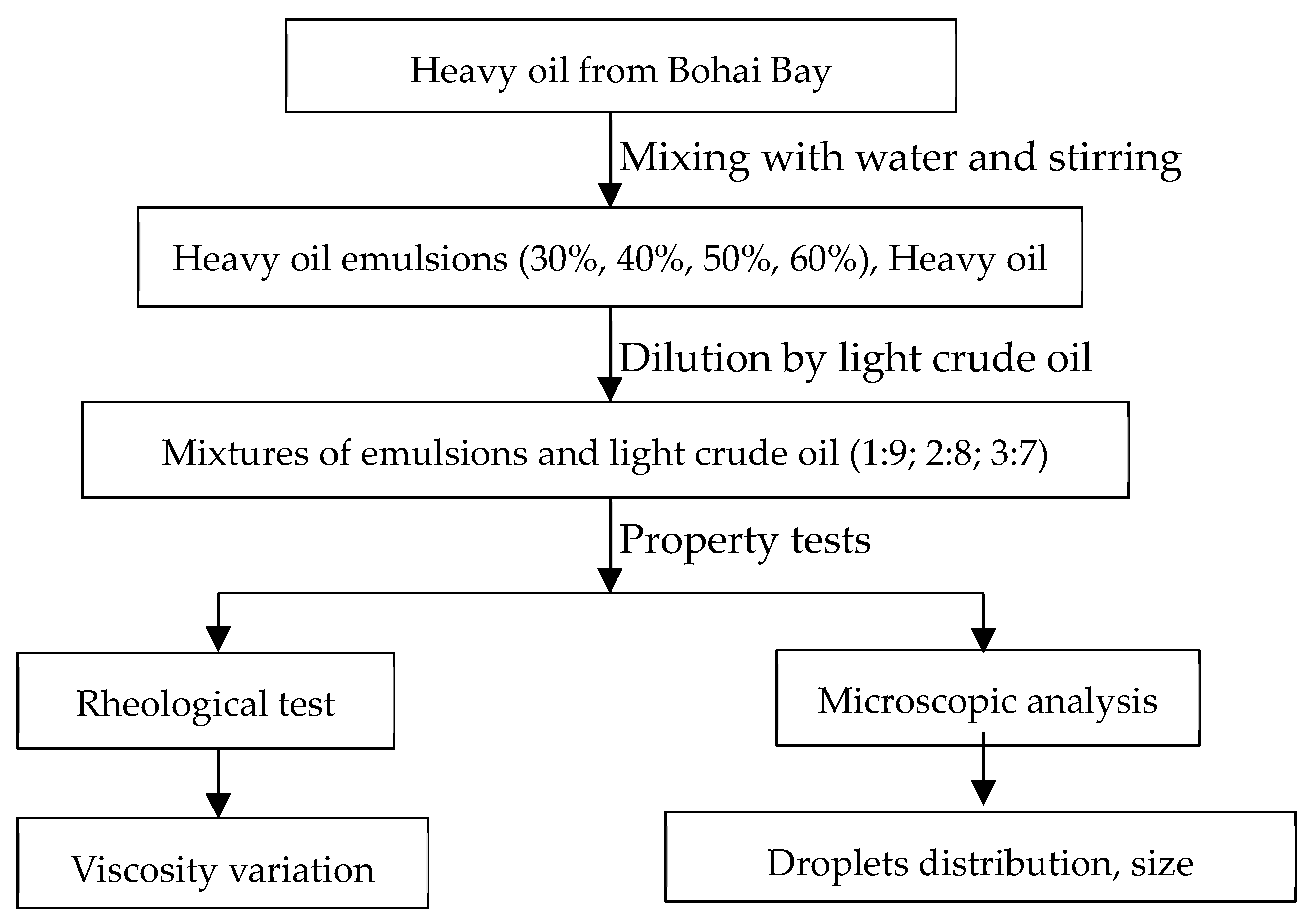




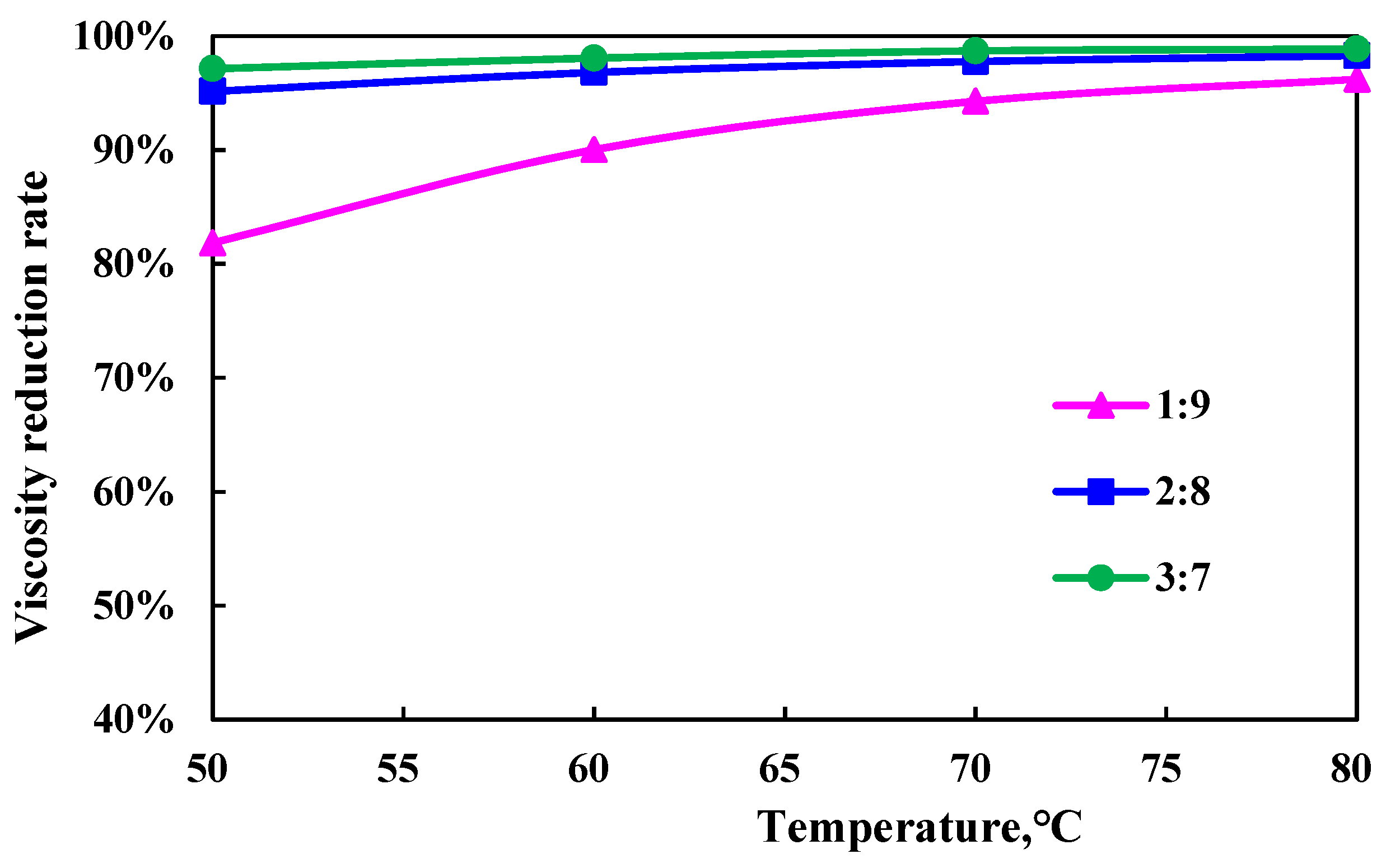
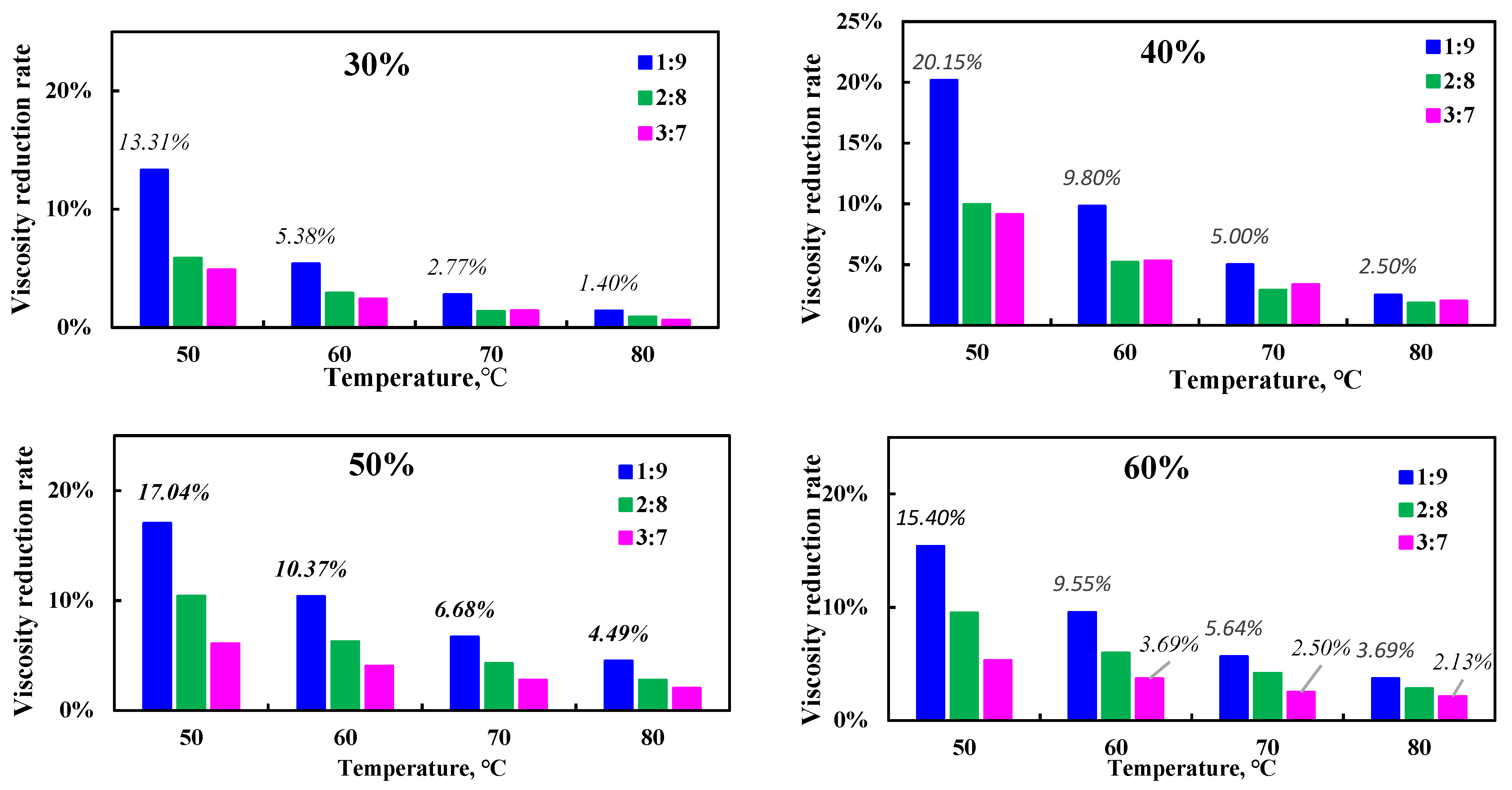
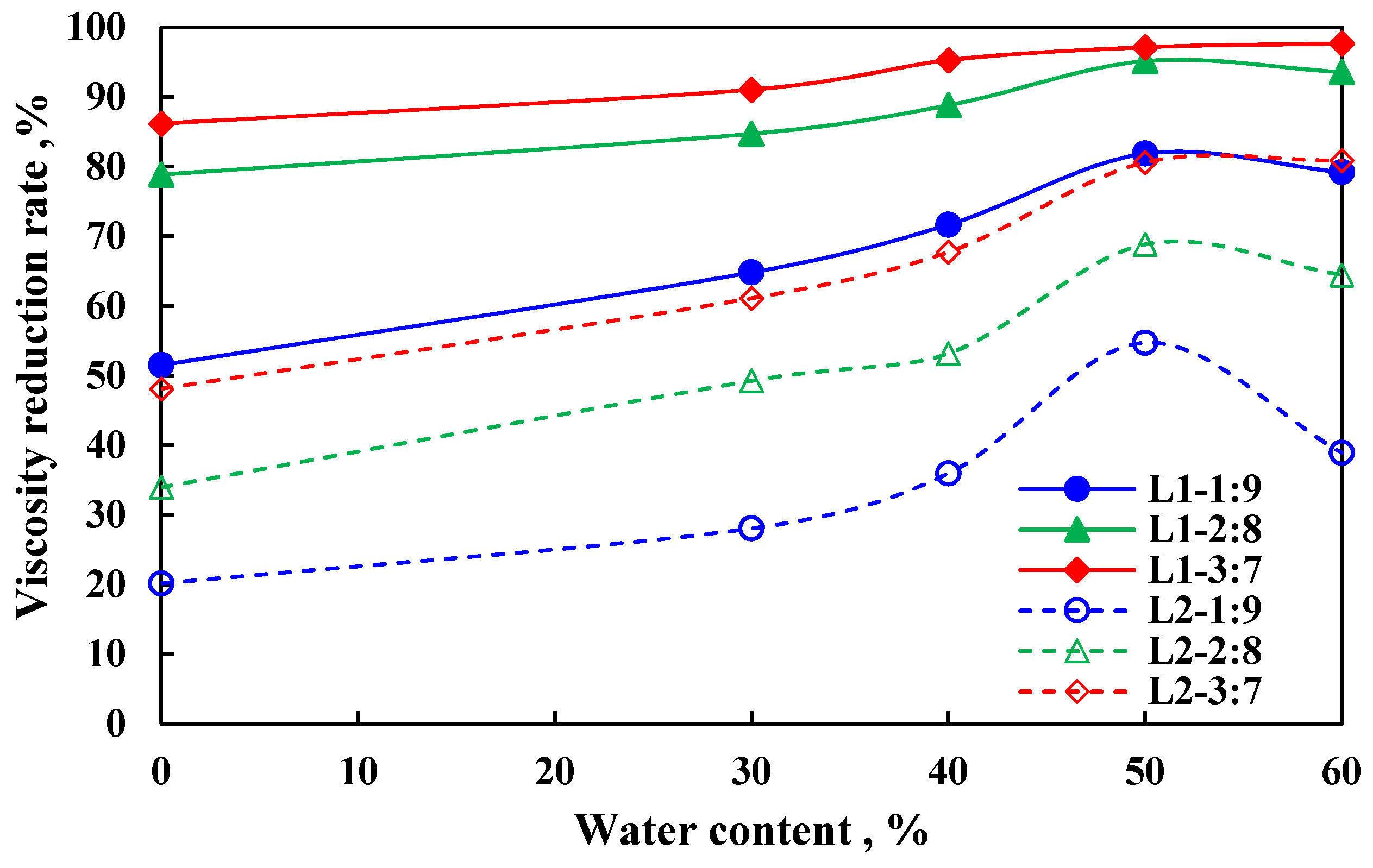



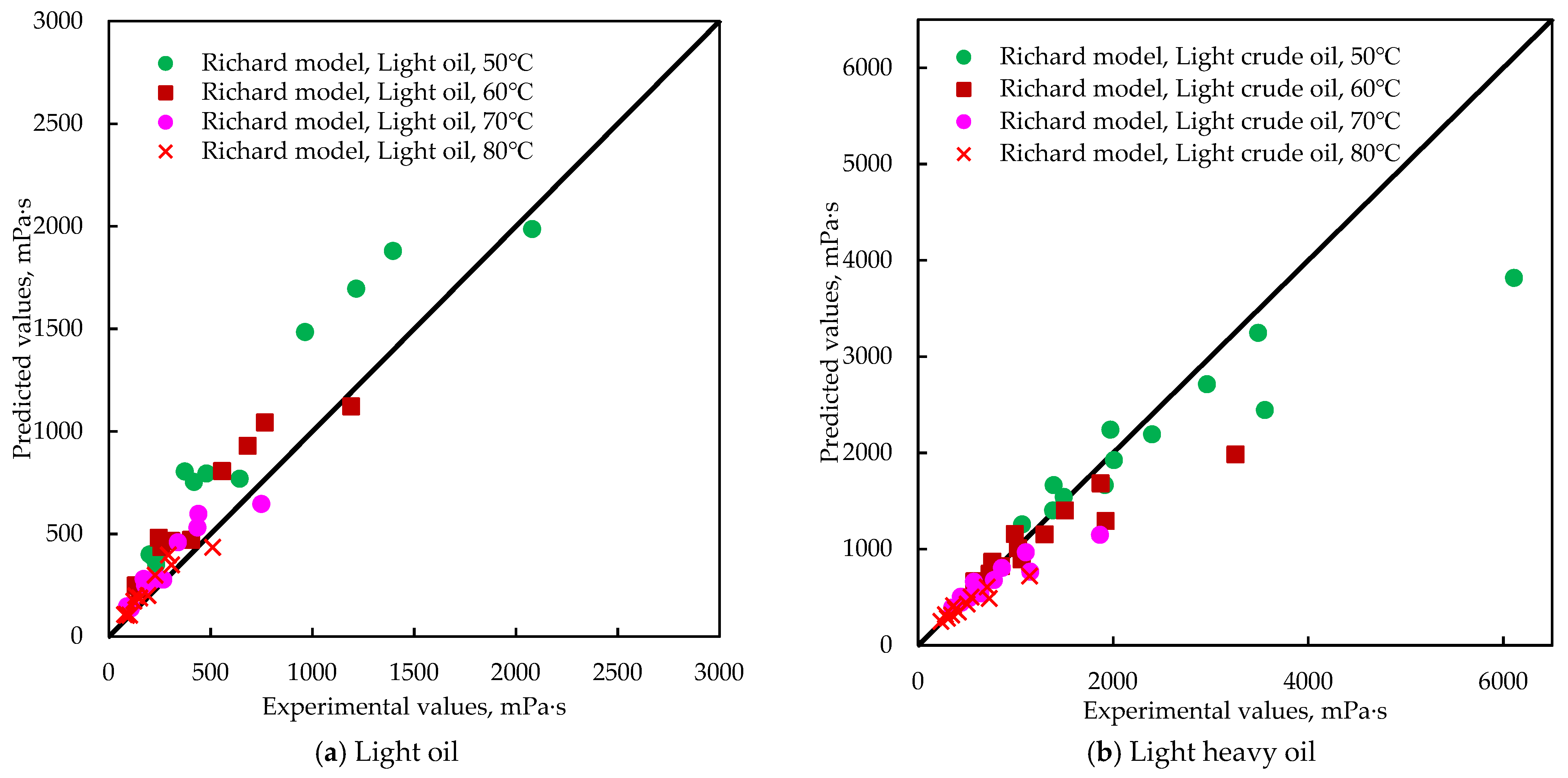
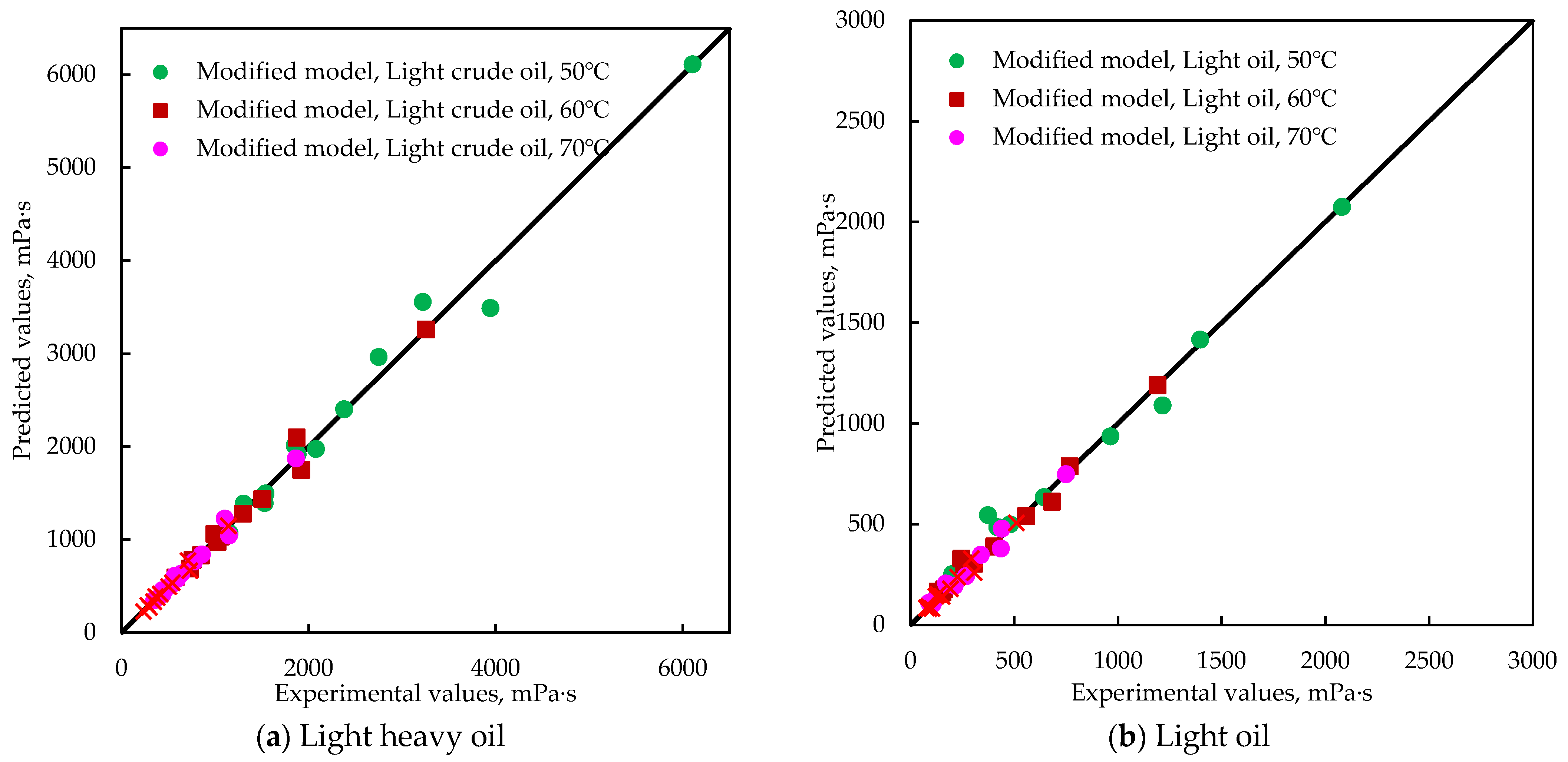
| Samples | L1 | L2 | A0 |
|---|---|---|---|
| Viscosity | 12.3 | 243.6 | 1453.0 |
| Temperature | 50 °C | 60 °C | 70 °C | 80 °C | |
|---|---|---|---|---|---|
| Water Content | |||||
| 0% | 1453 | 712 | 394 | 245 | |
| 30% | 2742 | 1350 | 753 | 453 | |
| 40% | 4290 | 2132 | 1181 | 723 | |
| 50% | 7698 | 3895 | 2234 | 1309 | |
| 60% | 9854 | 4983 | 2932 | 1658 | |
| Model | Formula |
|---|---|
| Richardson | |
| Einstein | |
| Brinkman | |
| Taylor | |
| Hatschek | |
| Krieger-Dougherty | |
| Guth-Simha | |
| Vand |
| Dilution Ratio | Water Content | Experimental Value by Dilution | Relative Deviation, % | |||||||
|---|---|---|---|---|---|---|---|---|---|---|
| Einstein | Brinkman | Taylor | Richardson | Hatschek | Krieger-Dougherty | Guth-Simha | Vand | |||
| 1:9 | 30% | 1973 | −3.2 | 26.9 | −26.6 | 13.5 | 63.4 | 20.1 | 56.2 | 46.1 |
| 2:8 | 30% | 1392 | 4.9 | 30.2 | −18.7 | 19.5 | 73.2 | 23.1 | 58.2 | 47.2 |
| 3:7 | 30% | 1067 | 6.1 | 25.5 | −15.8 | 17.6 | 71.6 | 18.8 | 49.4 | 39.0 |
| 4:6 | 30% | 915 | −16.6 | −5.6 | −32.1 | 5.1 | 53.9 | 4.7 | 27.8 | 19.4 |
| 5:5 | 30% | 747 | −33.8 | −27.7 | −44.6 | 0.0 | 46.6 | −1.3 | 16.3 | 9.5 |
| 1:9 | 40% | 2963 | −29.3 | 13.5 | −49.4 | −8.5 | 28.9 | 9.9 | 38.7 | 34.1 |
| 2:8 | 40% | 2010 | −22.6 | 12.7 | −43.2 | −4.4 | 36.0 | 7.4 | 39.4 | 32.3 |
| 3:7 | 40% | 1385 | −14.6 | 14.2 | −35.7 | 1.2 | 45.3 | 8.1 | 40.9 | 32.1 |
| 1:9 | 50% | 3488 | −35.8 | 34.6 | −56.2 | −7.0 | 29.3 | 41.5 | 50.4 | 53.5 |
| 2:8 | 50% | 2400 | −32.8 | 20.4 | −53.0 | −8.7 | 27.6 | 19.7 | 42.9 | 41.3 |
| 3:7 | 50% | 1495 | −19.4 | 26.2 | −41.9 | 3.1 | 45.6 | 21.6 | 54.9 | 49.0 |
| 4:6 | 50% | 1198 | −38.1 | −13.7 | −54.0 | −6.5 | 33.6 | 2.3 | 33.4 | 25.7 |
| 5:5 | 50% | 809 | −51.4 | −38.6 | −62.6 | −44.1 | −19.2 | −42.0 | −25.0 | −30.2 |
| 1:9 | 60% | 6111 | −62.0 | 12.8 | −75.1 | −37.6 | −12.8 | 48.1 | 4.6 | 13.9 |
| 2:8 | 60% | 3555 | −54.5 | 6.2 | −69.3 | −31.3 | −4.6 | 17.5 | 12.8 | 17.5 |
| 3:7 | 60% | 1916 | −37.7 | 18.6 | −56.8 | −13.1 | 21.0 | 20.1 | 37.9 | 38.0 |
| Mean absolute deviation, % | 28.9 | 20.5 | 45.9 | 13.8 | 38.3 | 19.1 | 36.8 | 33.0 | ||
| Light Crude Oil Type | Temperature/°C | Variable Coefficients | R2 | ||
|---|---|---|---|---|---|
| c1 | c2 | c3 | |||
| Light heavy oil (248 mPa·s, 50 °C) | 50 | 1.231 | 2.342 | 2.035 | 94.13% |
| 60 | 1.125 | 2.481 | 1.872 | 98.43% | |
| 70 | 1.048 | 2.609 | 1.706 | 98.53% | |
| 80 | 0.999 | 2.717 | 1.556 | 98.63% | |
| Light oil (12 mPa·s, 50 °C) | 50 | 1.018 | 2.074 | 2.815 | 98.59% |
| 60 | 1.148 | 1.994 | 3.228 | 98.61% | |
| 70 | 1.369 | 1.934 | 3.853 | 98.15% | |
| 80 | 1.424 | 1.920 | 3.750 | 97.04% | |
Disclaimer/Publisher’s Note: The statements, opinions and data contained in all publications are solely those of the individual author(s) and contributor(s) and not of MDPI and/or the editor(s). MDPI and/or the editor(s) disclaim responsibility for any injury to people or property resulting from any ideas, methods, instructions or products referred to in the content. |
© 2024 by the authors. Licensee MDPI, Basel, Switzerland. This article is an open access article distributed under the terms and conditions of the Creative Commons Attribution (CC BY) license (https://creativecommons.org/licenses/by/4.0/).
Share and Cite
Liu, Y.; Bai, J.; Guo, P.; Zhang, W.; Zhong, L.; Lyu, C.; Hao, Y.; Zhang, M.; Han, X.; Bi, P. Experimental Study on Water-in-Heavy-Oil Droplets Stability and Viscosity Variations in the Dilution Process of Water-in-Heavy-Oil Emulsions by Light Crude Oil. Energies 2024, 17, 332. https://doi.org/10.3390/en17020332
Liu Y, Bai J, Guo P, Zhang W, Zhong L, Lyu C, Hao Y, Zhang M, Han X, Bi P. Experimental Study on Water-in-Heavy-Oil Droplets Stability and Viscosity Variations in the Dilution Process of Water-in-Heavy-Oil Emulsions by Light Crude Oil. Energies. 2024; 17(2):332. https://doi.org/10.3390/en17020332
Chicago/Turabian StyleLiu, Yigang, Jianhua Bai, Peipei Guo, Wei Zhang, Liguo Zhong, Chaohui Lyu, Yi Hao, Mengqi Zhang, Xiaodong Han, and Peidong Bi. 2024. "Experimental Study on Water-in-Heavy-Oil Droplets Stability and Viscosity Variations in the Dilution Process of Water-in-Heavy-Oil Emulsions by Light Crude Oil" Energies 17, no. 2: 332. https://doi.org/10.3390/en17020332
APA StyleLiu, Y., Bai, J., Guo, P., Zhang, W., Zhong, L., Lyu, C., Hao, Y., Zhang, M., Han, X., & Bi, P. (2024). Experimental Study on Water-in-Heavy-Oil Droplets Stability and Viscosity Variations in the Dilution Process of Water-in-Heavy-Oil Emulsions by Light Crude Oil. Energies, 17(2), 332. https://doi.org/10.3390/en17020332





